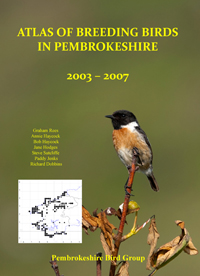Stonechat - 2003-07
 Friday, May 11, 2012 at 9:37PM
Friday, May 11, 2012 at 9:37PM The perky male Stonechat with its black head, ruddy breast and “tack–tack” call, accompanied by its browner mate, is frequently encountered in the county at all times of the year. Its distribution is mostly linked to that of gorse, be it associated with heather, bracken, grass or bramble. It has also demonstrated an ability to use new conifer plantations but this has proved to be a transient inhabitation, the habitat becoming progressively unsuitable with tree growth. Nests are usually sited low down in dense growth at the base of a bush or in a tussock.
Comparison of the two surveys indicates a spread from the coast in the St David’s area and in the Preseli Hills. Distribution at the coast tended to be linear, with a lower density than found at the more extensive heathlands. Donovan and Rees (1994) postulated a county breeding population of 200 pairs based on the 1984-88 survey plot, coupled with extensive experience of the areas involved. This estimate has generally been accepted as realistic for that time, bearing in mind the deflating effect of the cold winter of 1982. They concluded that the population was below optimum at that time.
The BBS has indicated that the Stonechat population increased in Wales by 338% between 1994 and 2007, in response to a period when there were no severe winters, conditions which have favoured this triple brooded species. As the Pembrokeshire population has expanded its distribution during this period and increased density was apparent in many localities, it seems reasonable to apply the BBS findings to Pembrokeshire. This suggests a population of 650 – 700 pairs by 2007, equating to an average of four pairs per occupied tetrad.
Graham Rees

Fieldwork 2003-07 (based on 490 tetrads)
Red = breeding confirmed = 96
Orange = breeding probable = 58
Yellow = breeding possible = 13
Total tetrads in which registered = 167 (34.1%)
 GHR,
GHR,  PBBA 2003-7 in
PBBA 2003-7 in  Stonechat
Stonechat 

Reader Comments